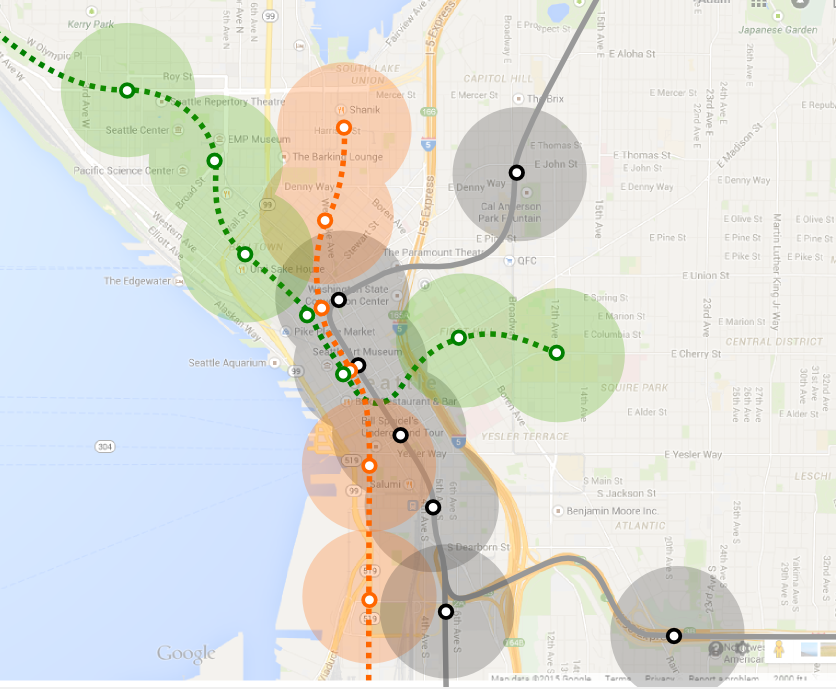Expanding Coverage of a Second Downtown Light Rail Tunnel

Existing and Conceptual Rail Coverage of Downtown Seattle (1/4 mile buffer around station)
For the last few decades the Downtown Seattle Transit Tunnel (DSTT) has served us well. Originally designed to provide a fast and reliable one-seat ride into downtown Seattle for commuters, it has evolved as our region and transit system have grown. The DSTT has been a resounding success contributing to a drive alone rate of just 23% for commuters in the historic 12-block "JCMSUP" commercial core.
The problem is that Downtown Seattle is quickly growing into a multipolar downtown, making it harder to serve with transit. Lower Queen Anne and South Lake Union have drive alone rates of 53% and 46% respectively, significantly higher than the commercial core. As I wrote several months ago there are several solutions to this problem including the "Pill Hill Solution", extending the routing of express buses into downtown adjacent neighborhoods, or encouraging transfers. All of these solutions have a role to play.
But what about light rail? How might it fit into the future of mobility in the Center City? As the possibility of a second light rail tunnel through Downtown Seattle moves forward I'd like to challenge the "traditional" transit vision popularized by the monorail of a single line running from Ballard to West Seattle. Why? Because South Lake Union happened.
Combined, South Lake Union and other poorly-connected Center City neighborhoods including Denny Triangle and First Hill currently contain 78% as many jobs as the JCMSUP commercial core (74,000 to 95,00) but more importantly can contain 350% as much future job capacity as the commercial core (47,775 to 14,000).*
If you look at existing and future residential capacities the equation is even more favorable to South Lake Union, Denny Triangle and First Hill. South Lake Union has more residential capacity than Ballard, the West Seattle Junction and Northgate combined. Clearly, improving mobility to these neighborhoods is essential for their continued growth and improved access to light rail is key to that end.
So how can coverage of these three areas by light rail be improved? Geometrically it's rather simple. Instead of running a single continuous line from West Seattle to Ballard (the "monorail solution"), two lines with a shared downtown tunnel and branching "tails" could be built. One of the two lines would run from West Seattle to Downtown, Denny Triangle and SLU while the other would run from Ballard to Belltown, Downtown and First Hill. Passengers could transfer between these lines and Link in the commercial core.
This simple geometric trick, which is being employed by Metro to extend the RapidRide C and D lines, would significantly improve light rail coverage of the Center City, especially in areas that current or proposed rail lines would miss. It would extend the reach of the Link for regional commuters making transfers faster and more reliable while also increasing downtown transit capacity. Eventually the tails could be extended to serve the Central District or the Aurora corridor.
Whether or not this solution is feasible or not is beyond my pay grade, but I hope that Sound Transit and the City of Seattle take a serious look at this idea when developing an ST3 package. At the very least, any second downtown tunnel should be design to accommodate future connections to these areas.
* See page 11 of the Seattle 2035 Development Capacity Report.